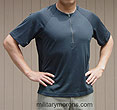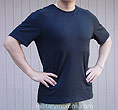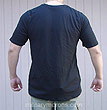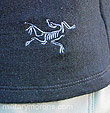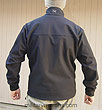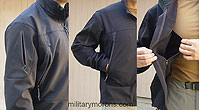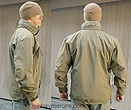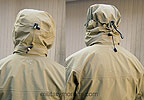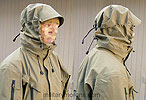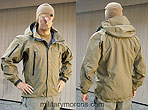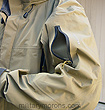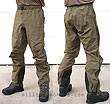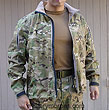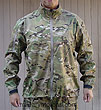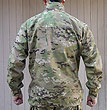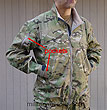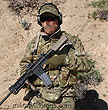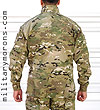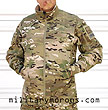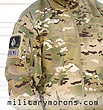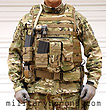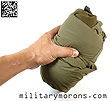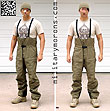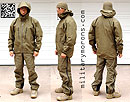Military Clothing (Non Uniform) Page
1 2
4
5 6
7 8 9
This section features Military clothing that are not uniforms/BDUs.
As a sizing reference: I'm 5'7", 155 lbs (yeah, I'm a little guy), medium build (BDU top medium/regular, BDU pant medium/short), waist 32", chest 43". Keep this in mind when you read my comments with respect to sizing, so you have an idea of how the garments featured below will fit on you. ALL garments in these pages are size Medium, unless stated otherwise.
TO VIEW FULL SIZE IMAGES: USERNAME and PASSWORD are both "mm"
ARC'TERYX LEAF (Law Enforcement and Armed Forces) Products
Note that the product line is subject to change - some of the items below may be discontinued or changed from the time the review is written.
| 4/23/05 -
Vancouver, BC, Canada-based Arc'Teryx
is a well-known name in the outdoor world, producing the latest, high-end
outdoor clothing, gear and accessories. Up till only a few years ago,
military clothing technology has usually been a step behind what's
been available on the civilian market. It makes sense that leading
manufacturers of 'technical' outdoor clothing are entering the military
market but it's more complicated than just producing civilian clothing
in 'military' colours. The Arc'Teryx
LEAF (Law Enforcement and Armed Forces) Purchase Program makes
special versions of their product line available to military and LE
professionals. 4/28/05 Blaze Zip Short Sleeve T-shirt
- The Blaze Zip SS T-shirt is a very
lightweight (5.1oz) T-shirt made out of 100% polyester Breezon™fabric,
which has a structured knit for next-to-skin moisture management.
The next-to-skin surface of the fabric has a tighter weave to wick
and absorb moisture while the outer surface has a more open weave
for faster evaporation. The colour shown here is 'Cinder', which is
an extremely dark grey, as far as I can tell. Not quite black. It's
available in crocodile as well.
Is a front zipper really necessary on a 'simple' T-shirt? Not until you wish you had one. It provides that little extra bit of temperature management that makes a difference. I was running in the evening at the time when it's usually a bit chilly, until I warm up and start to sweat. I experimented zipping and unzipping the front while running, to see how much of a difference it would really make, and it was quite noticeable. Zipping it all the way up closes up the collar, and keeps the wind out. Zipping it all the way down ventilates the entire shirt by making it that much looser while running, allowing air to circulate as I move, and warm air to vent. The Blaze also dried pretty quickly, and didn't have that soaked, clammy feel of cotton. I like the overall fit and cut of the shirt - it's unrestrictive when working out and smart-looking as well. Very comfortable. It's shirts like this one that are prompting the slow change over from cotton to synthetics in my wardrobe. 8/20/05 - Did a 7 mile medium-strenuous round-trip hike from 6000' to 10,000' with conditions ranging from hot at the lower altitudes to windy and chilly at the summit (still snow in some places). Wore the Blaze Zip T with my Kifaru Tailgunner and later with my wife's camelbak Hawg and I was comfortable the whole time. I never felt clammy or damp even though I was sweating quite profusely on the way up - the front zip was a plus as I could ventilate when needed and zip it up when it got chilly. Emissary Short Sleeve
T-shirt - The Emissary SS T-shirt
is a lightweight (6oz) summer shirt made out of superfine Merino wool.
Why wool? Wool has a lot of superior qualities, some of them being
durability, insulation for both hot and cold climates, absorbance
(wicking), flame resistance (natural fibers are recommended if exposure
to flame is a risk), and resilience, to name a few. I'll have to admit
that I've never been a fan of wool, as I've experienced itching with
most coarse fiber wool garments. It's only recently that I found out
that no one is really 'allergic' to wool - the discomfort or prickly
sensation is the skins reaction to fibers in the fabric that are greater
than a certain diameter. I'm one of those people cursed with extra
sensitive skin.
Enough about my skin - the Emissary shirt has flat-locked seams and a nice, athletic cut. Not as baggy as a regular shirt, and not too tight. It stretches with movement and is very comfortable, all around, when I got used to it. Plus the cool Arc'Teryx logo on the bottom. The main thing I noticed while wearing it was that it never felt too hot. I thought that it'd be warmer than a cotton tee, but it wasn't. Before lunch, everyday, I do a short workout in the temperature-controlled fitness room at work; enough to break a sweat. I definitely felt less warm and sticky with the Emissary shirt on than with my normal cotton tee. If you like Merino wool products, the Emissary might be a good choice for you. |
| Bravo Jacket - The Bravo Jacket shown here in black (also comes in crocodile and foliage green), is a weather-resistant, lightly insulated soft shell. The Bravo Jacket is based on a commercial style, the Gamma SV Jacket with the addition of sleeve pockets and internal pockets to the LEAF version. The Gamma SV is the jacket that started the softshell revolution in the outdoor industry back in 1998. Thousands of these have been produced since, and it remains one of Arc'Teryx's best sellers. In combination with the Gamma Salopette, it was one of the original garments ever made with PowerShield®. Arc'teryx and Malden Mills worked together to commercialize this fabric. So the Bravo jacket really is still the original softshell, updated. Constructed of Polartec® Power Shield ® and Tweave® Durastretch® ( pockets), the exterior of the fabric feels similar to the Bravo Pant, except that it is laminated to a thin insulating layer of fleece on the inside. A DWR finish provides water-resistance. Note that the DWR (water repellant treatment) will have to be 'renewed' after some time, just like Goretex, with a spray-on or wash-in treatment. As with the Bravo pant, the tight weave of the fabric is highly wind resistant, but not completely wind proof, as air can still be forced through. The Bravo jacket is designed to be worn alone, or with a light base layer. It combines the insulation of a light base layer with the protection of a soft-shell layer into one compact, quiet garment.
The brushed-lined 3" collar closes with a one-way
zipper. The rubberized front/felt-backed storm flap behind it is folded
over at the top to form a soft chin guard. The bottom hem of the jacket
can be tightened using the shock cord drawstring with pulls on each
side.
Like the Bravo Pants above (an most other Arc'Teryx
designs, I'm finding out), it's a very streamlined design, with very
little to snag or get in the way. Much of that is due to the low profile
of the pockets. Even when full, there are no flaps or bellows to catch
on anything. The jacket shares the high 13-stitch per inch count as
the pants, conveying the same impression of quality and neatness. |
|
Alpha Jacket - The Alpha Jacket shown below is a lightweight, feature-laden waterproof hard shell with stowable hood. The colour featured here is Arc'Teryx's 'Crododile', which is an olive drab/khaki shade, depending on whose colour you compare it to. It also comes in black. The main shell material is MI270 Gore-Tex® XCR®, which is a 3 layer fabric with great tear strength and abrasion resistance with a DWR finish for water repellency. Note that the DWR (water repellant treatment) will have to be 'renewed' after some time, with a spray-on or wash-in treatment . The Alpha is sized more generously than the Bravo or
Combat jackets and will fit over my PCU Level 3 high-loft pullover,
or over the Bravo jacket (which I found provides comparable insulation
to a PCU Level 2 long-sleeved shirt). Another reason for the looser
fit is that it's non-stretchable, so a bit more room is provided in
the right places to allow for freedom of movement without the jacket
being pulled. The extra room can be found in the shoulders, articulated
elbows and under the arms. The elbows have enough room such that bending
the arm doesn't pull the cuff back. In fact, I found that the the
Crye Combat Shirt with integral elbow pads would fit under the Alpha
jacket. The 14" water-resistant pit zips under the arms can be opened up from either end for ventilation. The cord zipper pulls have rubber shrink wrap on them to make them easier to locate and pull, especially with gloves. The sleeve cuffs have a slightly stiff, low-profile laminated velcro tab adjuster, which is very easy to use, secure, and forms a tight seal. The one-way main zipper in the front of the jacket is protected by a storm flap, which secures with small, round velcro patches, and snaps at the top and bottom.
When not in use, the hood is folded and stowed inside the zippered, full size compartment that runs the length of the collar. This of course, adds some bulk and stiffness to the collar, but I found that it really doesn't get in the way, as it tends to stand off away from the neck and face. The hood itself is by far the best I've ever used. It's large enough to fit over a helmet (I put it on over my Canadian Gallet), and is completely adjustable for use under a helmet or with no headgear at all. Adjustments are made via shock-cord pulls with cord-locks. The size of the hood opening is adjusted by pulling down on the two pull-tabs located on each side of the neck at the base of the collar. Pulling on the upper tab in the back of the head adjusts the circumference around the temples, so you have unhindered peripheral vision. The lower tab at the base of the skull pulls the upper tab backwards and down towards the neck, which snugs up the hood and also affects the ride height of the semi-stiff brim. The combination of these adjustments allow me to configure the hood exactly how I want it. No military Gore-Tex jacket hood should be without these features.
The upper arm pocket compartments are about 6"x7", with a 6" water-resistant zipper opening with cord pull. The side-entry hand pocket compartments are 10" tall, and 9" wide at the top, tapering to 7" wide at the bottom. The 9" zipper opening has a molded 'zipper garage' at the top, into which the zipper 'parks' when closed. The hand zippers have rubber wrapped cord pulls. On the inside, a laminated stretch-fabric pocket is located below the chest on each side, for smaller, flat items. Like the other Arc'Teryx garments on this page, all the pockets are characteristically low profile and unobtrusive.
The bottom of the jacket has shock-cord waist adjusters, which can be pulled with one hand. Looking inside the jacket, all seams are taped, sealed, and reinforced. The jacket is relatively light weight for a hard shell and compresses into a small enough package to stuff into a medium Kifaru pullout (about the size of a full 50oz camelbak bladder). The typical Arc'Teryx attention to quality and detail is apparent from the very neat, high-count stitching and various features. 12/3/06 - Alpha Pant - This is the matching pant to the Alpha Jacket shown above, also in crocodile. The Alpha Pant is constructed of the same MI270 Gore-Tex® XCR® 3 layer fabric as the jacket. Construction features are the same - high stitch count of 14-16 stitches per inch, lamination technology, WaterTight™ Zippers and Zipper Garages™ which ensure a leak free seal with reduced bulk and fewer seams. Shown below is the Medium size - my measurements are at the top of this page for reference. Like the Alpha Jacket, the Alpha Pant is patterned to allow maximum range of motion. It accomplishes this with a gusseted crotch and articulated knees. Since the Gore-Tex XCR doesn't stretch, extra material has been provided in the seat and knees to allow bending and squatting without being restrictive. That's the reason for the slightly looser looking seat and knees. There are full-length two-way watertight zippers on each side so the pants can be donned without taking your boots off. Opening the zipper from the top provides some ventilation. The main zipper pulls can be used with gloves.
The top of the side zippers are proteced in Arc'teryx's molded Zipper garage. The Alpha Pants have an elastic waist and an adjustable 1" web belt with low profile plastic buckle, which I find very comfortable. There are four suspender loops on the inside of the waist band. Everything that might potentially transfer moisture to the inside is sealed with die cut seam tape - all seams and even the embroidered logo on the front and side pocket. The fly has a two-way watertight zipper.
There are two side thigh pockets accessed by water proof zippers, about 7" x 6" square. They're flat when empty, but have a hidden pleat which lets them expand. I've mentioned this before, but Arc'Teryx has a knack for designing seemingly low profile pockets carry more than you'd think. And not even look bulky when they're full. On each instep is a patch of Schoeller® Keprotec®, which is 75% Nylon 25% Kevlar fabric that is extremely abrasion resistant. This patch protects the instep from cuts and abrasion from boots and crampons. The cuffs have adjustable shock cord and a snap closure to reinforce the bottom of the zipper. The end of the shock cord is pulled before the side zipper is closed. It stays inside the pant leg, out of the way of water or dirt. The shock cord channel is laminated to the inside of the pant leg. Wherever possible, Arc'teryx has used lamination technology to replace sewing, resulting in a leaner, more functional garment with less holes in the fabric.
Like the Alpha Jacket, the Pant is lightweight and very packable for a Gore-Tex garment. I much prefer the lighter weight Gore-Tex XCR to the heavier stuff. It's more comfortable and not as hot or bulky. I've found it advisable to always wear a base layer under Gore-Tex outer clothing, even if it's a very thin one. Unless you're standing still, you're going to sweat during exertion, oftentimes faster than it can evaporate or get transferred out of the garment. Wearing a very thin base layer like a Zensah tight or PCU L1 Pant underneath prevents that clammy feeling inside, and helps keep the skin dry and more comfortable.
|
| Combat Jacket - Shown below is a prototype of the Combat Jacket, done up in 50/50 NYCO MultiCam material treated with silicone by Epic® so it's water resistant. The material of the production model will be the same durable and lightweight Tweave® woven nylon of the above Bravo pant. The Combat Jacket is envisioned as a techincal alternative to the standard BDU top. It's more hard wearing, weather resistant, abrasion and tear-resistant, and more versatile. A similar-looking pattern to the Bravo jacket seen above, it differs from it by not having the fleece insulation and different pockets and minor features. The Combat Jacket is designed to be more form fitting than a BDU top, as the stretch fabric allows unrestricted freedom of movement. A full-length front zipper closure is backed by a rubberized storm flap, with a soft, felt-like backing on the reverse side. The storm flap is sewn over at the top of the collar to form a zipper chin-guard for comfort. The 2.5" tall collar can be worn up or folded over, and is lined with soft, non-chafing chamois.
Two mesh side-entry pockets with zipper closures are
located at waist level. On each shoulder/upper arm is another pocket,
with a vertical, zippered opening. It's non-pleated, but easily offers
enough room for a pair of flight gloves. One thing I'm noticing with
Arc'Teryx clothing is that they're very streamlined and 'smooth' designs
with very little to snag. You may not even notice the pockets except
for their openings, but they can hold more than you expect. I wore the combat jacket out in the desert during a
shooting trip instead of my Crye Field Shirt, with my STRIKE gear
over it, and appreciated its streamlined, low profile. It was very
comfortable to wear with gear with the minimum of bulk underneath.
|
Arc'Teryx Combat Jacket in Crye MultiCam
| 8/23/08 - It's been about three years since we first saw the prototype Arc'Teryx Combat Jacket from the LEAF (Law Enforcement and Armed Forces) division of Arc'Teryx in Crye MultiCam, and now, the production version is finally available. The Combat Jacket has been available in black and crocodile, but the development of the softshell MultiCam material is what took so long. The Combat Jacket was designed with comfort and versatility as the driving design factors, and is constructed with Arc'Teryx's signature quality and workmanship that have all the other companies playing catch-up. Material - The Arc'Teryx Combat Jacket is constructed of Tweave Durastretch fabric, which is a technical stretch woven with 92% nylon and 8% lycra spandex. Durastretch is a durable, abrasion resistant, water and wind resistant, low-bulk, breathable fabric with excellent stretch and recovery properties. The Multi-directional (4-way) permanent-stretch spandex has 100% memory for shape retention. The Tweave Duratretch used for the Combat Jacket is not laminated to a lining fabric - it is a single layer material (like the Bravo pants). It is designed more as a breathable shell for wind and moisture resistance than an insulating soft shell. This means that it can be used in warmer temperatures, and is very packable. It'll compress down into the same size as a BDU top. The DWR coating used on the Combat Jacket is the Schoeller NanoSphere DWR coating, which is water resistant and slick to the touch, even though the fabric is textured. Water beads up on the surface and it doesn't wet out when soaked for long periods. The nanoparticles in the NanoSphere finish form a fine structure on the textile surface. Water or substances such as oil or ketchup simply run off the NanoSphere surface which is naturally self-cleaning, and any residue can easily be rinsed off with a little water. The NanoSphere coating has a high level of abrasion resistance, and the protective function is retained even with heavy-duty use. The jacket therefore requires less frequent washings at lower temperatures (wash resistance is up to 100 washings). No fabric softener or dryer sheets are to be used. Here's a summary of the features on the Combat Jacket, size medium shown:
Sizing, fit etc - The Combat Jacket has what Arc'Teryx refers to as 'athletic patterning', which I usually take to mean 'form fitting but unrestrictive' - maybe with a bit more room around the shoulders and chest with a slimmer waist. It feels like it has a slightly more generous cut than the Bravo, with more space in the arm area. As expected, it's a very comfortable fit on me, being relatively form fitting without an excess of material to bunch up under a rig or another jacket. The seams are all flat for comfort under a ruck. General notes and thoughts- As mentioned in the prototype writeup, the Combat Jacket was envisioned as a technical alternative to the standard BDU top in cooler conditions, but more hard wearing, water and wind resistant, abrasion and tear-resistant, and more versatile. It can be worn alone like a BDU top ( over a thin base layer/t-shirt) or as part of a layering system. It's no more bulky than a standard BDU top, so it can be worn under other jackets if need be. Warm weather - I can see the Combat Jacket being a great alternative to a standard BDU top in cooler conditions, but what about in warmer weather? Being made of soft shell material, I fully expected the Combat Jacket to be a lot stuffier than your standard 50/50 NYCO or 100% cotton ripstop BDU top. Being the end of summer at the time of this writing, with warm and sometimes more humid weather, I gave the Combat Jacket a try in 75° weather. Anything about 70° is t-shirt weather for me, and no matter how you look at it, a BDU top is going to be warm in temperatures above 70°. I alternated the Combat Jacket with a BDU top and did some mild exertion (slow jog in the hot sun) to get me sweating. A few things stood out for me. The first was that much to my surprise, I didn't feel that the Combat Jacket felt any stuffier than a BDU top. Yes, I was hot and sweaty, but that was to be expected no matter what. The single-layer, uninsulated Tweave fabric doesn't seem to trap perspiration any more than a BDU top. The second thing that stood out were the huge pit zips. This made a big difference as a BDU top's only ventilation is through the open collar. If I was moving, I could feel some airflow through the jacket. The thrid thing was that when I got sweaty, the BDU top started getting soaked with sweat and sticking to my body and arms, as it normally does. When I moved my arms and extended them above my head, the BDU top would feel restrictive as it'd stick to my elbows and fore arms, and was completely non-elastic. The Combat Jacket on the other hand, doesn't absorb sweat and stays drier. It's not a wicking material and relies on evaporation and its breathability to transport the sweat away. I didn't feel like it stuck to me as much as the BDU top, and the elasticity of the Tweave made it completely non-restrictive in any position. So, I could raise my sweaty arms above me and move without feeling the top bind. If you have to wear a long -sleeved BDU top in warmer weather (for whatever reason - camo, protection etc), I don't think the Combat Jacket feels any less comfortable (to put it conservatively). Wet environments - In wet and cooler weather, this is where the Combat Jacket will have a distinct advantage over a standard BDU top. Bear in mind that the Tweave is not water proof, but highly water resistant. The DWR sheds water and it'll take a while for the material to let water through. When it does get wet, however, it dries much faster than a BDU, and doesn't hold as much water weight. If you've been immersed completely in water with BDUs, you know how heavy and sluggish waterlogged BDUs can feel when you come out of the water dripping wet. The single-later Tweave Combat Jacket will feel lighter and dry much faster. Another thing to consider is that the camouflage pattern on the Tweave material does not darken as much as a BDU when soaked. When BDUs get soaked, the pattern often gets so dark it's barely discernible and doesn't disrupt as it should. Plus, there's often a reflective, wet sheen on the BDU material just out of the water. The DWR on the Tweave beads up the water and keeps the sheen to a minimum. Look at the photo below of a 50/50 NYCO Crye BDU top sleeve next to the Combat Jacket sleeve. Both have been immersed in the sink with water the same time. The BDU sleeve has soaked through and the pattern darkened. The Tweave one looks pretty much the same underwater as it does dry. In summary, I believe that the Arc'Teryx Combat Jacket is fully capable of performing its intended role as a technical replacement for a BDU top; especially in cooler and wet environments. The single-layer weave fabric is thin, breathable and light enough to use it in warmer environments and it'll be no more uncomfortable than wearing a BDU top. It's uninsulated, so it can be layered over or under other garments. A base or mid layer is recommended for more warmth.
The last comment I'd like to make is on the level of quality, technology and workmanship that Arc'Teryx puts into their garments. I mentioned this a few years ago about Arc'Teryx and from what I can see, they're still the one for other companies to catch up to. It's evident when you look at the details. All the stitching is tight and straight, all seams and ends are finished without loose threads all over the place. Out of all the jackets that I have, the Arc'Teryx ones are the only jackets that are as well finished on the inside as the outside. Arc'Teryx is also an industry leader in utilizing new technology and methods in garment manufacture. Some companies are coming close, but Arc'Teryx still sets the standard (based on those that I have had experience with, of course).
|
| 11/7/09 - New for fall 2009 from the LEAF (Law Enforcement and Armed Forces) division of Arc'Teryx is the Atom LT Jacket. The Atom LT is a mid layer that functions as light outer wear. It's designed to be modern, warmer and more water-resistant alternative to the old M65 field jacket button-in liner, to which some manufacturers added buttons in the front so it could be worn as a stand-alone garment. It's a trim-fitting insulating jacket that can be worn as a layer under a hard shell to provide warmth, or by itself as a wind and water-resistant jacket. It is very lightweight for the warmth it provides and is highly compressible. I see it replacing a lot of mid-layers, sweatshirts and light weight fleece sweaters. Material - The Atom LT has a composite construction, utilizing different materials for the shell on the main body and side panels. The matte outer shell is made of super light Luminaria nylon weave which is thin yet durable, and treated with a DWR finish for water resistance. The smooth and silky inside liner is also made of Luminaria. The Atom LT is essentially the same jacket as that offered on the commercial side, but for LEAF, it's available in one additional colour - Crocodile (shown here), which is a khaki-ish olive and a subdued Bird logo on the left chest. The side panels are made of Polartec Power Stretch with Hardface Technology, which is a body-hugging 4-way stretch fabric with two unique surfaces - a soft fleece inner layer for warmth and comfort; and a smooth outer layer that is abrasion and snag/pick resistant. The main body and arms are insulated with 60g/m2 Coreloft which has a high warmth to weight ratio and rebounds quickly after compression. It is made up of two sizes of polyester fiber - the large fiber provides resilience and the small fiber provides air pockets for thermal efficiency. It has high loft in its normal state yet compresses down easily. Here's a summary of the features on the Atom LT Jacket, size medium shown:
Sizing, fit etc - The Atom LT is a 'trim fit', which on me is just about perfect. I'm not skinny nor chubby - sort of in the middle/average. It's designed to fit close to the body to minimize bulk when worn under other jackets/shells, and works very well in this role. On me, I wouldn't wear much more than a T-shirt or thin base layer under the Atom LT. If a heavy base layer is to be worn under it, going up a size might be warranted. With garments that aren't designed as mid layers, there can be a lot of excess material that bunches up or folds when worn under a jacket. Even those that are designed as mid layers can be bulky under the arms, if they're made of the same material throughout. The PCU Level 3 half-zip pullover had thinner panels on the sides to reduce bulk, but was not wind resistant and didn't perform well as a stand-alone garment when there was wind. The Atom LT's thinner side panels made out of Powerstretch minimize bunching at the armpits (also due to their cut), and allow air to pass through for ventilation when worn as a mid layer under a shell with pit zips, while the rest of the jacket is very wind resistant for stand-alone use. General notes and thoughts - The first thing I noticed when I picked up the Atom LT was how light it was. It's reminiscent of an insulating 'puff' jacket, but much lighter, more streamlined and less bulky. I also observed that the outer shell is completely matte. These no shine or reflection from it. When worn under a shell (like the Arc'teryx Alpha jacket), it's low profile enough that you don't feel like the Michelin man. I have full mobility without feeling any restrictions or stretching. It's not surprising that the Atom LT excels as a mid-layer/insulating layer under a shell, as that's what it was designed for. The low profile fit also makes it suitable for wearing under armour. As a stand-alone jacket/light outer shell, I predict that it's going to replace a lot of sweatshirts and fleece garments out there as the cool weather go-to top hanging by the door. Warmth is approximately equivalent to a 200-weight fleece garment but it's lighter, more comfortable, warmer (without being stuffy) and wind/water resistant - something sweatshirts or most fleece garments aren't. I tested out the water resistance of both the shell and side fleece panels and water just beads up and runs off (it's still new, of course, so that's to be expected with the DWR still fresh). Comfort is exceptional, as the inner fabric has a silky smooth finish and the fleece panels are very soft. Even the cuffs are more comfortable than regular knit cuffs. (It just occurred to me that this is sounding more like a bedsheet review than one for a jacket, but it's that comfortable). Another thing I like about the Atom LT is that it's very compressible for a 'puffy' jacket and more so than a fleece garment of equivalent warmth. It'll compress into the approximate size of a USGI canteen, which makes it quite easy to stuff into a bag or pack. It'll fit into my TNT bag side pockets, which are sized for the USGI canteen. More than a few times, I've left fleece jackets at home because they were too bulky to bring along, then regret my decision later when the weather turned colder than I expected. This is jacket that you want to stuff into your bag 'just in case' you might need it. It's light enough not to be a burden if you don't. Everyone has different needs and applications, but the Atom LT is one versatile garment which I feel most people will have use for quite often once cooler weather rolls around.
|
Arc'Teryx LEAF Alpha LT Jacket
| 12/18/09 - Another new item from the LEAF (Law Enforcement and Armed Forces) division of Arc'Teryx is the Alpha LT Jacket. The Gore-Tex Pro Shell Alpha LT isn't simply a lighter version of the Alpha, but more of a very advanced, light weight, Alpine wind shirt that's designed to provide full weather protection in a very packable garment. It was adapted from the civilian line Alpha LT with a change of colour (Crocodile) for the LEAF line, and abounds with high-tech construction features. Material - The Alpha LT is made from Gore-Tex® 3L Pro, which is a three-layer laminate consisting of a face fabric, the Gore-Tex® membrane, and a Gore Micro Grid backing fabric. It's engineered to excel in extended/extreme conditions while being tough, breathable, waterproof and wind proof. The Micro Grid backer is a thin, low-denier, low-density woven fabric that allows the shell to slide easily over mid layers. It also improves internal abrasion and snag resistance, enhances breathability and decreases garment weight. Compared to the Alpha Jacket, which is made of MI270 Gore-Tex® XCR®, the Alpha LT fabric has a smoother face, feels lighter and more supple, and has less of a 'crinkly' sound when moving. It still has the typical nylon 'swish' sound when moving. There is a very slight hue difference between the Alpha and Alpha LT material. The Alpha LT is ever so slightly greener. Here's a summary of the features on the Alpha LT Jacket, size medium shown:
Sizing, fit etc - The Alpha LT fits me the same as the Alpha Jacket - which means that my size medium has enough room for a relatively thick mid layer underneath. The Atom Lt jacket featured above is the perfect jacket liner for the Alpha LT, as it's form fitting and very light. The Gore-Tex 3L Pro isn't stretchy, so a bit more room is provided in the right places to allow for freedom of movement without the jacket being pulled. The extra room can be found in the shoulders and articulated elbows. The gusseted underarms prevent the cuffs from riding up when lifting the arms over the head. General notes and observations - The Alpha LT is referred to as a 'Level 6' garment, which in the SOF-PCU clothing system corresponds to the water proof rain suit. The Alpha LT really isn't just a lighter weight version of the Alpha jacket; there are also design/feature differences that have optimized it for light weight and packability. It is also more technologically advanced. The hood on the Alpha stows while the Alpha LT hood doesn't, and the arm pockets amd velcro of the Alpha are not present on the Alpha LT. While the Alpha isn't bulky, it's twice the weight of the Alpha LT and not as packable. The Alpha LT will fold down into approximately the volume of a USGI 1-quart canteen. Besides the lighter fabric, it achieves this through choice of components (lighter and more pliable water proof zippers, narrower seam tape, mini cord locks etc) and advanced construction technology (extensive use of welded seam and micro seams). This is one of the most technologically advanced garments I've seen, and it's only apparent upon close examination. Wherever possible, stitching has been eliminated in favour of welding and lamination. The micro seam allowance is a trip. When I examined the Alpha LT closely to see what this meant, I realized that there was no exposed stitching at the seams! Typically, I'll see Arc'teryx's very tight stitching joining the separate panels of the garment together. On the Alpha LT, there isn't any exposed thread to be seen. Instead of overlapping material and stitching it together with thread visible on the outside; on the LT, the two pieces of fabric are sewn together on the inside with a tiny seam allowance, and covered on the inside with seam tape, creating a very flat and non-bulky seam. So, from the outside, no threads are visible, which also means that they're not exposed to abrasion. All you can see is the parting line, and a hint of stitching underneath. See the photo below comparing the Alpha Jacket on the left and the Alpha LT on the right: The closer I examined the Alpha LT, the more I appreciated the details and technology that go into it. In my informal sink test, the Gore-Tex 3L Pro proved to be water proof - I wouldn't have expected anything different. I lined the sink with the Alpha LT and filled it up with as much water as I could, and left it for more than 24 hours. Water drops on the surface of the fabric beaded up and run off, as the water-repellant treatment (DWR) was still new, but when soaked for a long period along with pressure, the face fabric absorbed some water, which is to be expected. No water penetrated the Gore-Tex membrane, and the inside was dry, which is what counts. The face fabric dried very quickly, as it's very thin and can't hold much moisture. Like other Gore-tex fabrics, the DWR can be renewed with a spray-on renewer (I avoid wash-in as I have no control over where the DWR goes). I've found that in general, the DWR on most hard and soft shells will eventually wear and need renewing, especially on the shoulders and hood. The hood is very quick and easy to adjust. It's pretty amazing that a hood that is large enough to fit over a helmet can be adjusted down to give you a 'ninja slit' with barely more than my eyes showing. By cinching the adjustments down, I can snug the hood on my head enough so that it moves with my head, instead of my head moving inside it. Except at the extreme ranges of travel at each side, the hood can rotate enough to give me more than 180° of unrestricted vision. While the Alpha LT is not an insulated garment, it definitely provides some warmth from trapped body heat. The Alpha Jacket probably has the slight edge in durability, solely based on the thickness of the fabric, and has more load-carrying capability and features like the stowable hood. I see the Alpha Jacket used when wet and cold weather is a certainty, where it is worn most of the time and the extra storage in the shoulder pockets is needed. The role of the Alpha LT, as I see it, is as a garment that is compact and light enough to be packed or carried until it's needed for protection from the elements. It's light and compact enough to be brought along at the mere chance of adverse weather, where bringing a heavier garment might be cause for hesitation due to weight and size. The combination of the super-compressible Atom LT jacket/liner featured above and the Alpha LT are a great choice for covering a wide range of temperature and weather conditions when weight and packability are main concerns. |
| 2/27/10 - The Alpha Bib from Arc'Teryx LEAF is the bib version of the Alpha Pant reviewed previously. Built for harsh winter conditions or wet weather, the Alpha Bib provides maximum moisture protection with enhanced mobility and breathability. Extending to just below the chest, the low-cut Alpha Bib shields against blowing snow or rain, and keeps the kidneys warm. It features articulated shaping for unrestricted movement, watertight cargo pockets, and full length side zippers for venting and ease of donning. Material - The Alpha Bib is made from the same MI270 Gore-Tex® XCR® (Extended Comfort Range) fabric as the Alpha Jacket, which is a three-layer laminate engineered to excel in extended/extreme conditions while being tough, breathable, waterproof and wind proof. Gore-Tex XCR has 25% less resistance to moisture vapour transmission than Classic Gore-Tex which means that you stay drier inside. The fabric has a DWR finish for water repellency. Note that the DWR (water repellant treatment) will have to be 'renewed' after some time, with a spray-on or wash-in treatment . Here's a summary of the features on the Alpha Bib, size medium shown:
Sizing, fit etc - The Alpha Bib fits pretty much the same as the Alpha Pant, except that it's much more 'forgiving' around the waist since it doesn't have to be snug to prevent it from slipping down. Good for us not-so-young fellows that are letting ourselves go around the midriff. The Gore-Tex XCR isn't stretchy, so a bit more room is provided in the right places to allow for freedom of movement, like the seat and articulated knees. Just like the Alpha Pant, I find the fit very comfortable and unrestrictive. I have a short inseam, so the legs are a bit long for me, but since the cuffs are elasticized, it doesn't matter. General notes and observations - Quality and construction is typical Arc'Teryx; outstanding. Same tiny stitches as the other Alpha garments. The only caveat I see with the Bib is when nature calls. The Bib isn't convenient to drop if you've got to poop. If a full crotch zip can be added without compromising the durability and integrity of the crotch/seat, that'd be nice to have. However, I was told that the users of this garment didn't request one, and didn't want the possibility of a crotch zipper failing. Arc'Teryx does have bibs on the commercial side with full crotch zips. I didn't get the chance to go up into the snow this season, but did wear the Alpha Bib out in the wet (which we got a lot of this season). Not surprisingly, I was perfectly dry in the rain (I wore it with the Alpha LT jacket). The Bib does provide an extra measure of warmth around the mid-section, especially when there's a cold wind blowing. The design also eliminates the chances of it slipping down when crawling, and also helps keep the front of the body dry in the prone position if the jacket happens to ride up a bit. Based on my experience with the Alpha Pant on cold-weather hikes, the side zips really work well when exerting in cold weather, and you need to cool down quickly. Like the Alpha Pant, I find the Alpha Bib most comfortable with a very thin base layer (a pair of tights) as it keeps my skin drier if it becomes clammy inside from too much sweat, combined with a cold shell. If you're going to be spending time in the snow or wet, and some of that time laying on the ground, then you might appreciate the extra protection afforded by Alpha Bib. |
ATTENTION! PLEASE DO NOT LINK DIRECTLY TO MY IMAGES
-
IT RESULTS IN MY BANDWIDTH ALLOCATIONS BEING EXCEEDED,
AND MY PAGES GO DOWN. THANKS!
/ . PLEASE
OBSERVE AND RESPECT OUR COPYRIGHT! . /
©opyright by MilitaryMorons.com. All Rights Reserved. Reproduction, Duplication,
Distribution Strictly Prohibited.
Unless mentioned otherwise, content and images are the
property of militarymorons.com and are not in the public domain.
They are not to be used without
permission. Please Contact
me for permission to use any images or content herein.
